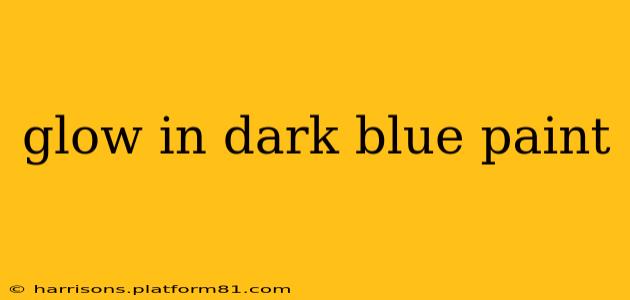Glow-in-the-dark paint has become increasingly popular for creative projects, adding a unique and magical touch to various applications. This guide explores the fascinating world of glow-in-the-dark blue paint, covering its types, uses, and considerations for achieving the best results. We'll delve into the science behind the luminescence and answer frequently asked questions to help you make informed choices for your next project.
What is Glow-in-the-Dark Blue Paint?
Glow-in-the-dark blue paint, also known as phosphorescent paint, contains phosphors – special crystals that absorb energy from light sources (like sunlight or UV light) and then slowly release it as light over time. This process is called phosphorescence, and it's what gives the paint its illuminating quality. The blue hue is achieved through the specific type of phosphor used in the paint's formulation. Unlike fluorescent paints, which need a constant light source to glow, phosphorescent paints continue to glow in the dark for a period after the light source is removed. The duration and intensity of the glow depend on factors like the quality of the paint, the amount of light it's charged with, and the surrounding environment.
What are the Different Types of Glow-in-the-Dark Blue Paint?
Several types of glow-in-the-dark blue paint cater to different needs and applications:
- Water-based paints: Easy to clean up and generally less toxic, making them suitable for indoor projects and crafts.
- Acrylic paints: Versatile and widely available, offering a good balance between durability, color intensity, and ease of use.
- Solvent-based paints: Often more durable and long-lasting, but require specific solvents for cleanup and may have stronger fumes.
- Spray paints: Provide quick and even coverage, ideal for larger surfaces but potentially less precise for intricate detailing.
Choosing the right type depends heavily on your project and desired outcome. Consider factors like the surface you’re painting, the level of durability needed, and your personal comfort level with different paint types.
How Long Does Glow-in-the-Dark Blue Paint Glow?
How long does glow-in-the-dark paint last? This is a common question. The glow duration varies significantly depending on the paint's quality and the charging time. High-quality paints can glow for several hours after a sufficient charge, while lower-quality paints might only glow for a short time. Generally, expect a brighter, shorter glow initially, gradually fading over several hours. Full recharging with a strong light source will restore the glow.
What Surfaces Can I Paint with Glow-in-the-Dark Blue Paint?
Glow-in-the-dark blue paint can be applied to a variety of surfaces including:
- Wood: Ideal for crafts, furniture, and home décor projects.
- Canvas: Excellent for creating glowing artwork.
- Metal: Suitable for decorating metal objects, though surface preparation is crucial for proper adhesion.
- Glass: Great for creating illuminated accents or designs on glass surfaces.
- Plastics: Works well on some plastics, but always test a small area first to ensure compatibility.
- Walls: Suitable for creating unique effects in rooms but always consider the long-term implications and potential cleanup difficulties.
Always pre-prepare surfaces with appropriate primers or cleaning to ensure the paint adheres well and provides the best glow.
How to Make Glow-in-the-Dark Blue Paint Glow Brighter?
To maximize the brightness and duration of your glow-in-the-dark blue paint:
- Charge it properly: Expose the painted surface to a strong light source – sunlight, UV light, or a bright LED lamp – for an extended period (at least 15-30 minutes) before expecting a significant glow.
- Use a high-quality paint: Invest in a reputable brand known for its luminescence properties.
- Apply multiple coats: Multiple thin coats tend to produce a brighter glow than one thick coat.
- Minimize exposure to light after charging: Keep the painted surface away from light sources when you want it to glow.
By following these tips, you can significantly enhance the luminous effect of your glow-in-the-dark blue paint project.
Can I Mix Glow-in-the-Dark Blue Paint with Other Paints?
Yes, you can mix glow-in-the-dark blue paint with other paints, but this will typically reduce the intensity of the glow. The more you dilute it, the dimmer the glow will be. Experimenting with small amounts is recommended to achieve the desired balance between color and luminescence.
This comprehensive guide should provide you with a solid foundation for understanding and successfully using glow-in-the-dark blue paint. Remember to always follow the manufacturer’s instructions for best results and safety.
